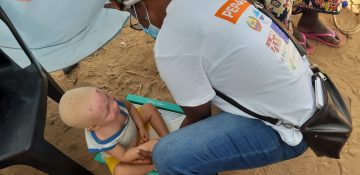Blog: Why global dermatological care should not be overlooked


Anne Schoenmakers
Medical Advisor & Researcher
June 23, 2022
Worldwide 900 million people suffer from skin diseases “at any time” (Source: World Health Organization). They account for between 10 and 30% of all contacts between health workers and patients (Source: Tropical Medicine and Infectious Disease). A skin rash or patch often seems harmless, but in some cases it can hide a long-term illness with serious consequences. The World Health Organization (WHO) stated that skin diseases are one of the top 10 causes of disability (Source: World Health Organization).
Most people know that particular skin lesions can be linked to skin cancer. But especially in countries with a tropical climate, skin rashes can also be a sign of HIV/AIDS or Neglected Tropical Diseases (NTDs). “Skin NTDs” is an umbrella term to describe a group of diseases that affect millions of people worldwide (Source: World Health Organization). Examples of skin NTDs are lymphatic filiariasis, scabies, onchocerciasis (river blindness) and leprosy. Marginalised populations, frequently living in remote settings, are affected most by these diseases. Because skin NTDs can cause disability, discrimination and stigma, they contribute to a vicious cycle of poverty as well as high health care costs.
The skin is the body’s largest and most visible organ and is a common starting point for disease recognition by trained health staff. Early diagnosis and proper treatment of skin NTDs can prevent chronic complications. Unfortunately, skin diseases – including skin NTDs – are often overlooked and not recognized in time by health professionals who received limited training in dermatology. A pale patch can be a sign of various diseases – for example vitiligo or a fungal infection – but in some settings it can also be a sign of leprosy, a disease in which early treatment is vital to prevent nerve damage. In many countries on the African continent, there is less than one dermatologist available per million inhabitants (Source: Dermatologic Clinics). For comparison, there are about 32 dermatologists per million inhabitants in the Netherlands (Source: Zorgkaart Nederland). It is therefore needed to bring specialised dermatological care closer to people who lack health care access.
Skin camps, a potential solution
Skin camps are an interesting approach in doing so. Skin camps are health events in communities where skin NTDs, such as leprosy, are present. They are organized in collaboration with community leaders, health workers and volunteers. Trained health staff – preferably including dermatologists – screen people for skin diseases and offer treatment or health centre referrals when needed. Not only skin NTDs are addressed during skin camps, but also more common skin diseases such as eczema and acne. People with skin diseases are thought to feel less reluctant to visit the events when a variety of diseases is included. Screening for two or more skin diseases during one intervention is called “integrated skin screening” (Source: PLOS Neglected Tropical Diseases). The WHO is supporting this approach, stating that it is expected to result in better health outcomes and greater cost-efficiency (Source: World Health Organization).
In Ethiopia, Mozambique and Tanzania, skin camps are also combined with the distribution of preventive medication for leprosy (single dose rifampicin), hoping to increase the health impact and efficiency even further (Source: BMJ Open). The effects of these skin camps are being studied as part of the PEP4LEP project. Nearly half of the visitors of the skin camps in these countries were suffering from skin diseases, people which were otherwise not likely to be (timely) diagnosed and treated. New, otherwise later or undiagnosed, leprosy patients are being detected through these skin camps. So far, over 5000 people received preventive medication for leprosy after their skin was screened in these community events.
What you can do
It is important to ensure global health care access for people suffering from skin problems. Early disease detection – for example via skin camps – can prevent disabilities and socio-economic consequences of treatable conditions like leprosy and other skin NTDs. Think and see in which ways you can include integrated skin screening in your interventions. Share your thoughts!
The PEP4LEP project is supported by the EDCTP2 program under Horizon 2020 (grant number RIA2017NIM-1839-441 PEP4LEP). The project also received funding from the Leprosy Research Initiative (LRI; www.leprosyresearch.org, grant number 707.19.58).
Honesty is the best policy.